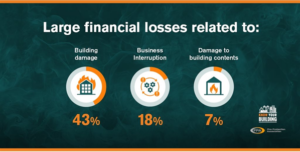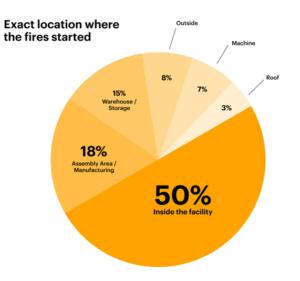Considering recent commercial fires, UK insurance companies are stressing the importance of passive fire protection in commercial properties. Passive fire protection, including firestopping and fireproofing materials, helps to slow the spread of fire and smoke, allowing occupants to evacuate safely and reducing damage to the building and its contents.
According to a recent survey by British Insurance Brokers, UK insurance companies are becoming increasingly concerned about the lack of proper passive fire protection in commercial properties. Many insurance companies are now requiring proof of compliance with fire safety regulations, including the installation and maintenance of passive fire protection systems, as a condition of coverage.
Data released recently by the FPA has revealed the significant financial impact on businesses and key services caused by fires. The analysis of 4,782 major UK fires between January 2009 and December 2019 where the financial loss was £100,000 or more revealed a mean average loss of £657,074 per incident. The analysis focuses on fires in buildings used by private and public sector organisations, and residential and mixed multiple occupancy shared ownership buildings.
Overall, loss values account for several areas, including damage to buildings (43% of the average value), interruption to business or services (18%), damage to contents (7%), damage to machinery or plant equipment (5%), loss of stock (5%) and loss of income or rent (2%).
Retail buildings were those most affected by large losses (15%), with 14% in industrial processing and manufacturing, 13% in accommodation buildings, 11% in pubs, bars and restaurants, 6% in the professional services sector, and 3% relating to education buildings.
Industrial processing and manufacturing buildings witnessed the largest overall financial impact through fires over the ten-year period, with losses totalling £808m.
The findings were collated and analysed by RISCAuthority, which is administered by the FPA, and mark the launch of the FPA’s Know Your Building campaign – aimed at improving levels of knowledge among building owners and managers to enable them to improve their organisational resilience to fire.

Jonathan O’Neill, managing director of the FPA, said: ‘These findings reveal the significant risk that fires pose not only to lives but also to livelihoods. It is not just the direct financial impact that organisations need to consider – the loss of critical assets and data, ability to supply critical services including housing, reduced working hours, sourcing replacement premises and materials, brand damage, loss of customers to competitors as well as the general stress and knock to staff morale is equally costly. These factors can jeopardise the survival of businesses and essential services, and the people that rely on them.
John Woollard, Technical Director at the Institution of Fire Engineers, says that passive fire protection is essential for protecting life and property in the event of a fire. “By slowing the spread of fire and smoke, passive fire protection gives occupants more time to evacuate, reduces damage to the building and its contents, and helps to ensure that insurance coverage remains in place,” he says.
The UK government has strict building regulations that require passive fire protection to be installed and maintained in accordance with relevant standards; If you own, manage, or operate a business, you need to comply with fire safety law. The main law is the Regulatory Reform (Fire Safety) Order 2005 or “the Fire Safety Order”. It applies across England and Wales and came into force on 1 October 2006. The Order applies to almost all buildings, places, and structures other than individual private homes – that’s individual flats in a block or family homes. Other places covered by the Order include shared areas in houses in multiple occupation (HMOs), blocks of flats and maisonettes. Approved Document B (Fire Safety) provides guidance about how the building regulations can be satisfied in common building situations, but these are not always applicable to more complex, larger building. BS 9999 takes a more holistic view of fire safety, allowing for compensatory measures to offset, for example, travel distances or escape door widths. The BS 476 suite of standards dictates the appropriate fire tests for elements of structure and materials. It also grades the level of fire resistance.
However, many commercial property owners are still not taking the necessary steps to ensure that their properties are adequately protected.

https://www.fsmatters.com/Resilinc-issues-warning-on-UK-factory-fires
To raise awareness about the importance of passive fire protection, industry groups are working with insurance companies to educate property owners about their obligations and the benefits of compliance. These organizations are also advocating for stronger enforcement of fire safety regulations and for increased investment in fire safety infrastructure.
In conclusion, UK insurance companies are underlining the importance of passive fire protection in commercial properties to protect life and property and to ensure compliance with fire safety regulations. Property owners are urged to take the necessary steps to ensure that their properties are adequately protected, including regular inspections and maintenance of passive fire protection systems.

Interesting information. Will this result in cheaper premiums for property owners?